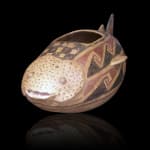Casas Grandes Bowl in the Form of a Fish, 1160 CE - 1260 CE
Terra Cotta
7 x 5 x 14.75
DC.0702
This Pre-columbian hanging-pot, depicting a fish in vivid color and acute form, is a piece that exemplifies the mastery of prehistoric American art. Around the static bowl-shape, rounded fins and...
This Pre-columbian hanging-pot, depicting a fish in vivid color and acute form, is a piece that exemplifies the mastery of prehistoric American art. Around the static bowl-shape, rounded fins and a heart-shaped face-plate have been crafted. Truly, a large and rounded object such as the fish-body is an impossibly cantankerous composition in which to employ movement. The fins and tail on their own are simply not large enough to offer the fantastic liveliness and near-human presence of this fantastic piece.
The movement may be ascribed to the ingenious painting scheme. Across the fish’s body cut jagged black waves, further drawn out by red counter-designs, that slim the body of the fish and give it the sense of moving forward, through water. The diagonals across the dorsal and pectoral fins further stress the activity and intention of the piece. On the tail, red streaks fan out across the tail, encompassing bold black arrow that very literally points the fish in the direction of its travel. Across the top, a rich black-dominated checker pattern firmly grounds the spine and head of the fish.
The presence of this object, the affable and friendly nature of it, is very plainly written on its face. The ingenious oblong shape of the bowl creates an ideal frame for the broad forehead, the forward facing eyes, and the long plane of the cheeks. The jagged cut of the smile gives way to a toothy, gentle mouth.
People, throughout history, have found friendliness, companionship, and human qualities in the animal world. For those of us who talk to our pets, who wonder about their feelings- this piece is a reminder that we are not and have not be alone. The personality in the animal be it real or fantastical, has been immortalized and encapsulated in this piece. The goofy and whimsical nature of the fish affects us as much as it did our Pre-Columbian ancestors.
The movement may be ascribed to the ingenious painting scheme. Across the fish’s body cut jagged black waves, further drawn out by red counter-designs, that slim the body of the fish and give it the sense of moving forward, through water. The diagonals across the dorsal and pectoral fins further stress the activity and intention of the piece. On the tail, red streaks fan out across the tail, encompassing bold black arrow that very literally points the fish in the direction of its travel. Across the top, a rich black-dominated checker pattern firmly grounds the spine and head of the fish.
The presence of this object, the affable and friendly nature of it, is very plainly written on its face. The ingenious oblong shape of the bowl creates an ideal frame for the broad forehead, the forward facing eyes, and the long plane of the cheeks. The jagged cut of the smile gives way to a toothy, gentle mouth.
People, throughout history, have found friendliness, companionship, and human qualities in the animal world. For those of us who talk to our pets, who wonder about their feelings- this piece is a reminder that we are not and have not be alone. The personality in the animal be it real or fantastical, has been immortalized and encapsulated in this piece. The goofy and whimsical nature of the fish affects us as much as it did our Pre-Columbian ancestors.



